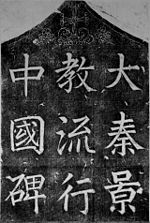- Alopen
-
 Detail of the Nestorian Stele artifact, mentioning Alopen
Detail of the Nestorian Stele artifact, mentioning Alopen
Alopen (Chinese: 阿罗本 pinyin: Āluóběn) (also "Aleben", "Aluoben", "Olopen," "Olopan," or "Olopuen" and Chinese 景净 (pinyin: jǐng jìng)) is the first recorded Christian missionary to reach China, during the Tang Dynasty. He was a Nestorian, and probably a Syriac-speaker from Persia.[1] He is known exclusively from the Nestorian Stele, which describes his arrival in the Chinese capital of Chang-an in AD 635 and his acceptance by Emperor Taizong. His is the earliest known name that can be attached to the history of Nestorianism in China.
History
Alopen's name is known only from the Chinese of the Nestorian Stele. This may be a transliteration of the Semitic "Abraham".[2] According to the Stele, Alopen and his fellow missionaries came to China from Daqin (or Ta Tsin – the Roman Empire) in the ninth year of Emperor Taizong (Tai Tsung) (635), bringing sacred books and images.[3] He would have come to China via the Silk Road. The Nestorian mission benefited from Taizong's policy of religious tolerance, which reversed measures his father Gaozu had taken against Buddhism and other foreign religions and influences.[1]
According to the Stele, Taizong welcomed Alopen and arranged for the translation of the holy writings he had brought with him at the Imperial Library. Upon studying them, Taizong, a great scholar and patron, found them most acceptable and arranged for their dissemination. Indeed, four documents from the early period of Christianity in China (the Jesus Sutras) date to around Alopen's time.[1] Three years later, in 638, Taizong issued an official declaration protecting the Nestorian church. He erected China's first Christian church and recognized twenty-one priests, likely all Persians, to administer it. Under Taizong's son and successor Gaozong, who continued this policy of toleration, Alopen's status expanded even further, and he was appointed bishop over the many churches built by the emperor.[4]
After Alopen's time Nestorianism was prominent in China for the remainder of the Tang Dynasty's power. Different emperors treated it differently, with some showing it the tolerance it received in the early decades, and some openly persecuting it. Nestorianism disappeared with the fall of the Tang Dynasty in the early 10th century. It did not return for three centuries, when it was reintroduced by the Mongols.[1] The story of Alopen became prominent again in the 17th century, when the Nestorian Stele was rediscovered and the Chinese were surprised to see that the "new" religion being preached by the missionaries, had actually been in existence in China more than 10 centuries earlier.
References
- ^ a b c d Moffett, Samuel Hugh (1999). "Alopen". Biographical Dictionary of Christian Missions: 14–15. http://books.google.com/books?id=oQ8BFk9K0ToC&printsec=frontcover#v=onepage&q=&f=false.
- ^ P. Y. Saeki, The Nestorian Documents and Relics in China, 2nd ed., Tokyo: Academy of Oriental Culture, 1951
- ^ Ding, Wang (2006). "Renmants of Christianity from Chinese Central Asia in Medieval ages". In Malek, Roman; Hofrichter, Peter (editors). Jingjiao: the Church of the East in China and Central Asia. Steyler Verlagsbuchhandlung GmbH. ISBN 9783805005340.
- ^ "Nestorian Tablet: Eulogizing the Propagation of the Illustrious Religion in China, with a Preface, composed by a priest of the Syriac Church, 781 A.D.". East Asian History Sourcebook. www.fordham.edu/halsall. http://www.fordham.edu/halsall/eastasia/781nestorian.html. Retrieved January 28, 2010.
External links
Syriac Christianity Churches (West Syrian) Churches (East Syrian) Historically: Church of the East - Related: Nestorianism
Presently: Ancient Church of the East · Assyrian Church of the East · Chaldean Catholic ChurchChurches (in India) Historically: Malankara Church
Presently:
Eastern Oriental: Chaldean Syrian Church (Assyrian Church of the East in India)
Orthodox: Jacobite Syrian Christian Church · Malankara Orthodox Syrian Church (Indian Orthodox Church)
Catholic: Syro-Malabar Catholic Church · Syro-Malankara Catholic Church
Reform: Malabar Independent Syrian Church · Malankara Mar Thoma Syrian Church · St. Thomas Evangelical ChurchLanguages Assyrian Neo-Aramaic · Bohtan Neo-Aramaic · Chaldean Neo-Aramaic · Garshuni · Hértevin · Koy Sanjaq Surat · Syriac · Mlahsô · Senaya · TuroyoNational identity Categories:- Church of the East
- Christian interfaith and secular relations
- Christian missionaries in China
- Nestorianism in China
- 7th-century bishops
Wikimedia Foundation. 2010.
